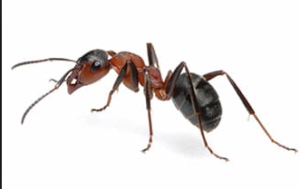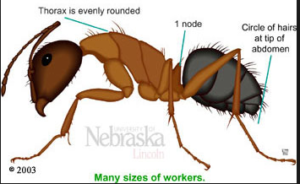How to Kill and Control Carpenter Ants
Carpenter ant control can be a little tricky, but yet have good results with a little persistence. One of the first steps in control is the inspection. Inspection for carpenter ants provides the information needed to make good decisions when it comes to a treatment strategy. The inspection helps you identify the locations of activity, possibly help you find the nest, and also locate any conducive conditions that might be leading to having the Carpenter ant infestation, to begin with. 
Controlling Carpenter ants is really a 3 step approach. The first step is to create a layer of protection on the exterior of the structure. This can be done by applying Termidor, Premise, or some residual insecticide on the outside of the house. Using Termidor for example, you would apply a band 1 foot up and 1 foot out along the foundation as it meets the ground. In addition, treat around doors, windows, and eaves of the house. Also, treat all visible trails where carpenter ants travel. I suggest you treat carpenter ants in the evening time, as late as possible, since Carpenter ants are nocturnal in nature.
The second step in Carpenter ant control is treating the exterior off of the structure. Your inspection should tell you where Carpenter ants are traveling, and we would want to control Carpenter ants in this area. Examples would be garbage areas, planting beds, trees, living or dead, overgrown vegetation, and piles of wood. These areas would be a great area to apply the Advance Granular Carpenter Ant Bait or the Maxforce insect bait. Carpenter ants are highly attracted to piles of the bait as opposed to having to pick up a broadcast bait like a Fire Ant. Carpenter ants tend to trail along edges, such as sidewalks, fences and borders of flower beds, and treatment with the same insecticide as on the structure can be used here.
The final Carpenter ant control step is the treatment indoors. Indoor treatments for Carpenter ants can include the use of a spray, a bait, foam or any combination of the 3. Once again, locating the hot spots of activity and applying the materials in those areas is important. Phantom aerosol or Phantom liquid are 2 good formulations with low odor and good residual protection. Putting these materials where the suspected nesting site is located is key to success. Also, if you know where there is a possible nesting site, the use of Premise Foam is a great tool to gain control of the Carpenter ant colony. Premise foam will fill up the carpenter ant gallery and nesting site and leave a good residual to prevent them from returning. Carpenter ant control products like baits are also effective indoors. Be sure to place the baits near the carpenter ant trails and activity. When the ants find the bait, they will recruit other workers to come to help them take the bait back to the colony. Areas to do this might be in the attic, in a crawlspace, or basement. In addition, if you can follow the ants back after they take the ant bait, once again you can hit them with the Premise foam or Phantom products. 
Online sites offer a wide range of pest control products and pest control supplies to control every type of pests and insects. From control of termites, bed bugs, and cockroaches to moles, pigeons, and scorpions. All insecticides and pest control products are for doing it yourself pest control, but we don’t really recommend you using these poisons yourself in your house. so give the professionals like us a call today.
